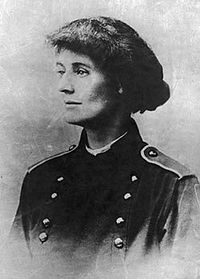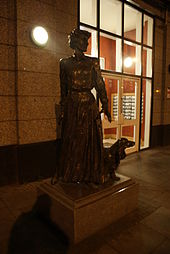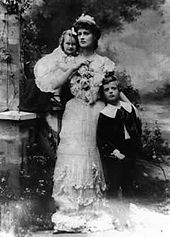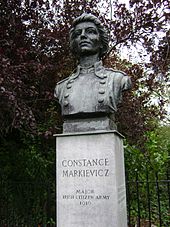- Constance Markievicz
-
Constance Georgine Markievicz 
Countess Markievicz Member of Parliament In office
1918–1922Constituency Dublin St Patrick's Teachta Dála In office
December 1918 – May 1921Constituency Dublin St Patrick's In office
May 1921 – June 1922In office
August 1923 – July 1927Constituency Dublin South Minister for Labour In office
April 1919 – January 1922Preceded by New office Succeeded by Joseph McGrath Personal details Born Constance Georgine Gore-Booth
4 February 1868
Buckingham Gate,
London, EnglandDied 15 July 1927 (aged 59)
Sir Patrick Dun's Hospital,
Dublin, IrelandResting place Glasnevin Cemetery,
Dublin, IrelandPolitical party Sinn Féin,
Fianna FáilSpouse(s) Casimir Markievicz (m. 1901) Children Maeve Markievicz Religion Church of Ireland, Roman Catholic Military service Allegiance Irish Republican Brotherhood
Irish Citizen Army
Irish Republican Army
Cumann na mBanYears of service 1913–1923 Rank Second-in-command
ColonelBattles/wars Dublin Lockout
Easter Rising
Irish War of Independence
Irish Civil WarConstance Georgine Markievicz, Countess Markievicz (Polish: Markiewicz; née Gore-Booth; 4 February 1868 – 15 July 1927) was an Irish Sinn Féin and Fianna Fáil politician, revolutionary nationalist, suffragette and socialist. In December 1918, she was the first woman elected to the British House of Commons, though she did not take her seat and along with the other Sinn Féin TDs formed the first Dáil Éireann. She was also one of the first women in the world to hold a cabinet position (Minister for Labour of the Irish Republic, 1919–1922).[1]
Contents
Early life
She was born Constance Georgine Gore-Booth at Buckingham Gate in London, the elder daughter of the Arctic explorer and adventurer Sir Henry Gore-Booth, 5th Baronet, an Anglo-Irish landlord who administered an 100 km2 (39 sq mi) estate, and Lady Georgina née Hill. During the famine of 1879–80, Sir Henry provided free food for the tenants on his estate at Lissadell in the north of County Sligo in the north-west of Ireland. Their father's example inspired in Gore-Booth and her younger sister, Eva Gore-Booth, a deep concern for the poor. The sisters were childhood friends of the poet W. B. Yeats, who frequently visited the family home Lissadell House in County Sligo, and were influenced by his artistic and political ideas. Yeats wrote a poem, In Memory of Eva Gore-Booth and Con Markiewicz, in which he described the sisters as "two girls in silk kimonos, both beautiful, one a gazelle". Eva later became involved in the labour movement and women's suffrage in England, although initially the future countess did not share her sister's ideals.
Marriage and early politics
Gore-Booth decided to train as a painter, but at the time only one art school in Dublin accepted female students. In 1892 she went to study at the Slade School of Art in London.[2] It was at this time that Gore-Booth first became politically active and joined the National Union of Women's Suffrage Societies (NUWSS). Later she moved to Paris and enrolled at the prestigious Académie Julian where she met her future husband, Count Casimir Markievicz (Polish: Kazimierz Dunin-Markiewicz), an artist from a wealthy Polish family that owned land in what is now Ukraine.[3] He was married at the time, but his wife died in 1899 and he wed Gore-Booth in London on 29 September 1900 making her Countess Markievicz.[4] She gave birth to their daughter, Maeve, at Lissadell in November 1901.[4] The child was raised by her Gore-Booth grandparents and eventually became estranged from her mother. Countess Markievicz also undertook the role of mother to Nicolas, Kazimierz's son from his first marriage, who then accompanied Markievicz and Kazimierz to Ireland. It was claimed that Markievicz was particularly fond of him and was devastated by his decision to return to Poland. Knowing that her arrest was imminent after the 1916 Rising, she had to stash a silver shotgun that Nicolas had given her.
The Markieviczes settled in Dublin in 1903 and moved in artistic and literary circles, the Countess gaining a reputation for herself as a landscape painter. In 1905, along with artists Sarah Purser, Nathaniel Hone, Walter Osborne and John Butler Yeats, she was instrumental in founding the United Artists Club, which was an attempt to bring together all those in Dublin with an artistic and literary bent. At this time, there was nothing tangible to link her to revolutionary politics, but socialising in this milieu she met the leading figures of the Gaelic League founded by the future first President of Ireland, Douglas Hyde. Although formally apolitical and concerned with the preservation of the Irish language and culture, the league brought together many patriots and future political leaders. Sarah Purser, whom the young Gore-Booth sisters first met in 1882, when she was commissioned to paint their portrait, hosted a regular salon where artists, writers and intellectuals on both sides of the nationalist divide gathered. At Purser's house, Markievicz met with revolutionary patriots Michael Davitt, John O'Leary and Maud Gonne. In 1906, Markievicz rented a small cottage in the countryside around Dublin. The previous tenant was the poet Padraic Colum who had left behind old copies of The Peasant and Sinn Féin. These revolutionary journals promoted independence from British rule. The Countess read these publications and was propelled into action.
 Sketch of Constance Markievicz by John Butler Yeats
Sketch of Constance Markievicz by John Butler Yeats
In 1908, Markievicz became actively involved in nationalist politics in Ireland. She joined Sinn Féin and Inghinidhe na hÉireann ('Daughters of Ireland'), a revolutionary women's movement founded by the actress and activist Maud Gonne, muse of W. B. Yeats. Markievicz came directly to her first meeting from a function at Dublin Castle, the seat of British rule in Ireland, wearing a satin ball-gown and a diamond tiara. Naturally, the members looked upon her with some hostility. This refreshing change from being "Kowtowed"-to as a countess only made her more eager to join. She performed with Maud Gonne in several plays at the newly established Abbey Theatre, an institution that played an important part in the rise of cultural nationalism. In the same year, Markievicz played a dramatic role in the women's suffrage campaigners' tactic of opposing Winston Churchill's election to Parliament during the Manchester North West by-election, flamboyantly appearing in the constituency driving an old-fashioned carriage drawn by four white horses to promote the suffragist cause. One male heckler asked her if she could cook a dinner, to which she responded, "Yes. Can you drive a coach and four?" Her sister Eva Gore-Booth had moved to Manchester to live with fellow suffragette Esther Roper and they both campaigned against Churchill with her. Churchill lost the election to Conservative candidate William Joynson-Hicks, at least in part as a result of the suffragists' dedicated opposition.[5]
In 1909 Markievicz founded Fianna Éireann, a para-military nationalist scouts organisation that instructed teenage boys and girls[6][7][8] in the use of firearms. Patrick Pearse said that the creation of Fianna Éireann was as important as the creation of the Irish Volunteers in 1913. The Countess was jailed for the first time in 1911 for speaking at an Irish Republican Brotherhood demonstration attended by 30,000 people, organised to protest against George V's visit to Ireland. During this protest Markievicz handed out leaflets, erected great masts: Dear land thou art not conquered yet., participated in stone throwing at pictures of the King and Queen and attempted to burn the giant British flag taken from Leinster House, eventually succeeding, but then seeing James McArdle imprisoned for one month for the incident, despite the Countess testifing in court that she was responsible.[9] Her friend Helena Moloney was arrested for her part in the stone throwing incident and became the first woman ever to be tried and imprisoned for a political act since the time of the Ladies Land League.[9]
Markievicz also joined James Connolly's socialist Irish Citizen Army (ICA), a small volunteer force formed in response to the lockout of 1913, to defend the demonstrating workers from the police. Markievicz, though an aristocrat, held sympathy with the ordinary workers. Markievicz recruited volunteers to peel potatoes in a basement while she worked and others worked on distributing the food. All food was paid out of her own pocket, Markievicz was forced to take out many loans at this time and sold all her jewellery. That same year, with Inghinidhe na hÉireann, she started a soup kitchen to feed poor school children.
She was involved in the Howth gun-running. On 26 July 1914, when the Asgard unloaded arms in Howth harbour, it was met by the Irish Citizen Army, led by Markievicz, ready with hand carts and wheelbarrows. Also present were Bulmer Hobson, Douglas Hyde, Darrell Figgis, Peadar Kearney and Thomas MacDonagh.[10]
Easter Rising
In 1913 her husband moved to Ukraine, and never returned to live in Ireland. However, they did correspond and Kazimierz was present by her side when she died in 1927. As a member of the ICA, Markievicz took part in the 1916 Easter Rising. She was deeply inspired by the founder of the ICA, James Connolly, and she both designed the uniforms of the ICA and composed their anthem, a Polish song with changed lyrics. Markievicz held the rank of an officer, making her a decision maker, and more importantly, giving her the right to carry arms.
During the Rising, Lieutenant Markievicz was appointed second in command to Michael Mallin in St Stephen's Green.[11] She supervised the setting-up of barricades as the rising began and was in the middle of the fighting all around Stephen's Green, wounding a British army sniper. Inspired by newsreel footage from the Western Front, they initially began to dig trenches in the Green. British fire from the rooftops of adjacent tall buildings, including the Shelbourne Hotel, however, soon convinced them of the folly of this tactic, and they withdrew to the adjacent Royal College of Surgeons.
Mallin and Markievicz and their men held out for six days, finally giving up when the British brought them a copy of Pearse's surrender order. The English officer, Captain Wheeler (aka Major de Courcy Wheeler), who accepted their surrender was a relative of Markievicz.
They were taken to Dublin Castle and the Countess was then transported to Kilmainham Gaol. They were jeered by the crowds as they walked through the streets of Dublin. There, she was the only one of seventy women prisoners who was put into solitary confinement. At her court-martial on 4 May 1916, the Countess pleaded not guilty to "taking part in an armed rebellion...for the purpose of assisting the enemy," but pleaded guilty to having attempted "to cause disaffection among the civil population of His Majesty" and she told the court, "I did what I thought was right and I stand by it." Her conviction was assured, only her sentence was in doubt. She was sentenced to death, but General Maxwell commuted this to life in prison on; "account of the prisoner's sex." It was widely reported that she told the court, "I do wish your lot had the decency to shoot me". The prosecuting counsel, William Wylie, later to be appointed a High Court judge in 1924, wrote to his daughter and alleged that she said "I am only a woman, you cannot shoot a woman" and that she had "never stopped moaning the whole time she was in court".[12]
The Countess was transferred to Mountjoy Prison and then to Aylesbury Prison in England in July 1916. She was released from prison in 1917, along with others involved in the Rising, as the government in London granted a general amnesty for those who had participated in it. It was around this time that Markievicz, born into the Church of Ireland, converted to Catholicism.
First Dáil
In 1918, she was jailed again for her part in anti-conscription activities. At the 1918 general election, Markievicz was elected for the constituency of Dublin St Patrick's, beating her opponent William Field with 66% of the vote, as one of 73 Sinn Féin MPs. This made her the first woman elected to the British House of Commons. However, in line with Sinn Féin abstentionist policy, she would not take her seat in the House of Commons.
Markievicz was in Holloway prison, when her colleagues assembled in Dublin at the first meeting of Dáil Éireann, the unilaterally declared Parliament of the Irish Republic. When her name was called, she was described as being "imprisoned by the foreign enemy" (fé ghlas ag Gallaibh).[13] She was re-elected to the Second Dáil in the House of Commons of Southern Ireland elections of 1921.[14]
Markievicz served as Minister for Labour from April 1919 to January 1922, in the Second Ministry and the Third Ministry of the Dáil. Holding cabinet rank from April to August 1919, she became both the first Irish female Cabinet Minister and at the same time, only the second female government minister in Europe.[1][15] She was the only female cabinet minister in Irish history until 1979 when Máire Geoghegan-Quinn was appointed to the then junior cabinet post of Minister for the Gaeltacht for Fianna Fáil.
Civil War and Fianna Fáil
Markievicz left government in January 1922 along with Éamon de Valera and others in opposition to the Anglo-Irish Treaty. She fought actively for the Republican cause in the Irish Civil War helping to defend Moran's Hotel in Dublin. After the War she toured the United States. She was not elected in the 1922 Irish general election but was returned in the 1923 general election for the Dublin South constituency. In common with other Republican candidates, she did not take her seat. However, her staunch republican views led her to being sent to jail again. In prison, she and 92 other female prisoners went on hunger strike. Within a month, the Countess was released.
She joined Fianna Fáil on its foundation in 1926, chairing the inaugural meeting of the new party in La Scala Theatre. In the June 1927 general election, she was re-elected to the 5th Dáil as a candidate for the new Fianna Fáil party, which was pledged to return to Dáil Éireann, but died only five weeks later, before she could take up her seat.[16]
She died at the age of 59, on 15 July 1927, possibly of tuberculosis (contracted when she worked in the poorhouses of Dublin) or complications related to appendicitis. Her estranged husband and daughter and beloved stepson were by her side. She is buried at Glasnevin Cemetery, Dublin. Éamon de Valera, the Fianna Fáil leader, gave the funeral oration.
The by-election for her Dáil seat in Dublin South was held on 24 August 1927 and won by the Cumann na nGaedheal candidate Thomas Hennessy.
“ One thing she had in abundance—-physical courage; with that she was clothed as with a garment. ” See also
- List of suffragists and suffragettes
- Women's Social and Political Union
- Women's suffrage in the United Kingdom
- List of Sligo people
- List of people on stamps of Ireland
- Electoral firsts in the United Kingdom
References
- ^ a b Alexandra Kollontai was People's Commissar (Minister) for Social Welfare of Soviet Russia from 1917 to 1918.
- ^ "Countess Markievicz (Constance Markievicz)". Centre for Advancement of Women in Politics. http://www.qub.ac.uk/cawp/Irish%20bios/TDs_2.htm#markievicz. Retrieved 6 June 2008.
- ^ "Constance Markievicz: The Countess of Irish Freedom". The Wild Geese today. http://www.thewildgeese.com/pages/ireland.html.
- ^ a b "Constance Georgine Gore-Booth". The Lissadell Estate. http://www.constancemarkievicz.ie/marriage.php. Retrieved 8 August 2011.
- ^ Marecco, Anne (1967). The Rebel Countess. Weidenfield and Nicholson.
- ^ Ward, Margaret (1983). Unmanageable Revolutionaries: Women and Irish nationalism. London: Pluto Press. p. 104. ISBN 0861047001.
- ^ Irish Freedom, August 1912.
- ^ Hobson, Bulmer (1968). Ireland Yesterday and Tomorrow. Tralee: Anvil Books. p. 16.
- ^ a b Ward, Margaret (1983). Unmanageable Revolutionaries: Women and Irish nationalism. London: Pluto Press. p. 78. ISBN 0861047001.
- ^ Martin, Francis Xavier, 1922-2000 (ed.). The Howth gun-running and the Kilcoole gun-running, 1914 [Recollections and documents]; foreword by Éamon de Valera. Dublin: Browne and Nolan, (1964)
- ^ Ward, Margaret (1983). Unmanageable Revolutionaries: Women and Irish nationalism. London: Pluto Press. p. 112. ISBN 0861047001.
- ^ Dr Jonathan Bardon, A Short History of Ireland
- ^ John McGuffin (1973). "Internment – Women Internees 1916–1973". http://www.irishresistancebooks.com/internment/intern6.htm. Retrieved 22 March 2009.
- ^ "Countess Constance de Markievicz". ElectionsIreland.org. http://electionsireland.org/candidate.cfm?id=994. Retrieved 22 March 2009.
- ^ Ward, Margaret (1983). Unmanageable Revolutionaries: Women and Irish nationalism. London: Pluto Press. p. 137. ISBN 0861047001.
- ^ "Countess Constance Georgina de Markievicz". Oireachtas Members Database. http://www.oireachtas.ie/members-hist/default.asp?housetype=0&HouseNum=5&MemberID=298&ConstID=90. Retrieved 22 March 2009.
Sources
- S. Pašeta (2004), Markievicz , Constance Georgine, Countess Markievicz in the Polish nobility (1868–1927), Oxford University Press, http://www.oxforddnb.com/view/article/37472, retrieved 17 September 2006
Further reading
- Seán O'Faoláin, Constance Markievicz (1934)
- Anne Marreco, The Rebel Countess: The Life and Times of Constance Markievicz (1967)
- Diana Norman, Terrible Beauty: A Life of Constance Markievicz, 1868-1927 (1987)
- Anne Haverty, Constance Markievicz: Irish Revolutionary (1993)
- Joe McGowan, Constance Markievicz: The People's Countess (2003)
- A lecture by Ruth Dudley Edwards criticising Countesss Markievicz, broadcast by RTE on 6 November 2006.
External links
- Detailed Countess Markievicz info
- Article on Constance Markievicz
- Her impassioned speeches in the Treaty Debates.
Parliament of the United Kingdom Preceded by
William Field
(Irish Parliamentary Party)Sinn Féin MP for Dublin St Patrick's
1918–1922Constituency abolished Oireachtas New constituency Sinn Féin Teachta Dála for Dublin St Patrick's
1918–1921Constituency abolished New constituency Sinn Féin Teachta Dála for Dublin South
1921–1922Succeeded by
Myles Keogh
(Independent)Preceded by
New seat in constituencySinn Féin Teachta Dála for Dublin South
1923–1927Succeeded by
Herself
as a Fianna Fáil TDPreceded by
Herself
as a Sinn Féin TDFianna Fáil Teachta Dála for Dublin South
June–July 1927Succeeded by
Thomas Hennessy
(Cumann na nGaedheal)Political offices New office Minister for Labour
1919–1922Succeeded by
Joseph McGrathEaster Rising Signatories of the Proclamation of the Republic
(executed after the Rising)Also executed for their role in the Rising Other Irish figures Éamon de Valera · Constance Markievicz · The O'Rahilly · Eoin MacNeill · Cathal Brugha · Richard Mulcahy · Liam Mellows · Seán MacEntee · Tomás Mac Curtain · Thomas Ashe · Francis Sheehy-Skeffington · Helena Moloney · Michael CollinsBritish figures Categories:- 1868 births
- 1927 deaths
- British female MPs
- British suffragists
- Burials at Glasnevin Cemetery
- Converts to Roman Catholicism from Anglicanism
- Female Teachtaí Dála
- Fianna Fáil politicians
- Irish revolutionaries
- Irish Sinn Féin politicians
- Irish socialists
- Irish Christian socialists
- Members of the 1st Dáil
- Members of the 2nd Dáil
- Members of the 4th Dáil
- Members of the 5th Dáil
- Members of the United Kingdom Parliament for Irish constituencies (1801–1922)
- People from County Sligo
- People of the Easter Rising
- People of the Edwardian era
- People of the Irish Civil War
- Teachtaí Dála
- UK MPs 1918–1922
- Women in war
- Women of the Victorian era
Wikimedia Foundation. 2010.



